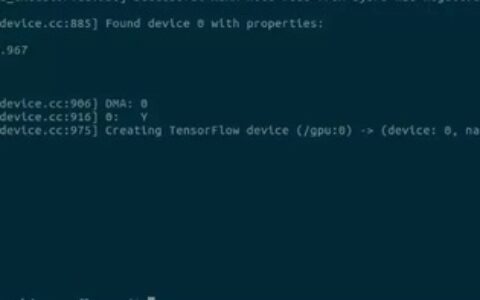使用TensorFlow DataSet实现高效加载变长文本输入的完整攻略
在本文中,我们将提供一个完整的攻略,详细讲解如何使用TensorFlow DataSet实现高效加载变长文本输入,包括两个示例说明。
什么是TensorFlow DataSet?
TensorFlow DataSet是一种高效的数据输入管道,可以帮助我们快速地加载和预处理数据。它可以处理各种类型的数据,包括图像、文本、音频等,并支持多种数据格式,如CSV、TFRecord等。
如何使用TensorFlow DataSet加载变长文本输入?
在处理文本数据时,我们通常会遇到变长文本输入的情况,即每个样本的长度不一致。这时,我们可以使用TensorFlow DataSet提供的TextLineDataset和tf.data.Dataset.padded_batch方法来实现高效加载变长文本输入。
以下是使用TensorFlow DataSet加载变长文本输入的示例代码:
import tensorflow as tf
# 读取文本文件
dataset = tf.data.TextLineDataset('data.txt')
# 定义map函数,将文本转换为数字
def map_func(line):
words = tf.strings.split(line, ' ')
nums = tf.strings.to_number(words, out_type=tf.int32)
return nums
# 对每个样本进行padding
padded_shapes = tf.TensorShape([None])
dataset = dataset.map(map_func).padded_batch(32, padded_shapes=padded_shapes)
# 迭代数据集
for batch in dataset:
print(batch)
在这个示例中,我们首先使用TextLineDataset方法读取文本文件。接着,我们定义了一个map_func函数,用于将文本转换为数字。然后,我们使用padded_batch方法对每个样本进行padding,并指定batch size为32。最后,我们使用for循环迭代数据集,并打印每个batch的内容。
示例1:使用TensorFlow DataSet加载变长文本输入
以下是使用TensorFlow DataSet加载变长文本输入的示例代码:
import tensorflow as tf
# 读取文本文件
dataset = tf.data.TextLineDataset('data.txt')
# 定义map函数,将文本转换为数字
def map_func(line):
words = tf.strings.split(line, ' ')
nums = tf.strings.to_number(words, out_type=tf.int32)
return nums
# 对每个样本进行padding
padded_shapes = tf.TensorShape([None])
dataset = dataset.map(map_func).padded_batch(32, padded_shapes=padded_shapes)
# 迭代数据集
for batch in dataset:
print(batch)
在这个示例中,我们首先使用TextLineDataset方法读取文本文件。接着,我们定义了一个map_func函数,用于将文本转换为数字。然后,我们使用padded_batch方法对每个样本进行padding,并指定batch size为32。最后,我们使用for循环迭代数据集,并打印每个batch的内容。
示例2:使用TensorFlow DataSet加载变长CSV文件
以下是使用TensorFlow DataSet加载变长CSV文件的示例代码:
import tensorflow as tf
# 读取CSV文件
dataset = tf.data.experimental.CsvDataset('data.csv', [tf.float32, tf.string], header=True)
# 定义map函数,将文本转换为数字
def map_func(x, y):
words = tf.strings.split(y, ' ')
nums = tf.strings.to_number(words, out_type=tf.int32)
return x, nums
# 对每个样本进行padding
padded_shapes = (tf.TensorShape([]), tf.TensorShape([None]))
dataset = dataset.map(map_func).padded_batch(32, padded_shapes=padded_shapes)
# 迭代数据集
for batch in dataset:
print(batch)
在这个示例中,我们首先使用CsvDataset方法读取CSV文件。接着,我们定义了一个map_func函数,用于将文本转换为数字。然后,我们使用padded_batch方法对每个样本进行padding,并指定batch size为32。最后,我们使用for循环迭代数据集,并打印每个batch的内容。
结语
以上是使用TensorFlow DataSet实现高效加载变长文本输入的完整攻略,包括了如何使用TextLineDataset和CsvDataset方法读取文本数据,以及如何使用padded_batch方法对变长文本进行padding。在处理文本数据时,使用TensorFlow DataSet可以帮助我们快速地加载和预处理数据,提高模型训练的效率。
本站文章如无特殊说明,均为本站原创,如若转载,请注明出处:使用tensorflow DataSet实现高效加载变长文本输入 - Python技术站

 微信扫一扫
微信扫一扫  支付宝扫一扫
支付宝扫一扫 

